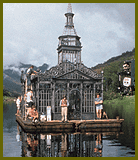Simpson finally found the perfect setting in remote Jackadgery, which is located more than 1,000 miles from Sydney. "The terrain was so inhospitable that even before a frame of film could be shot, the company had to spend a big chunk of money on building a 16-kilometer road just to get us into the place," Simpson recalls. "That was the first obstacle. Then poor Steve Courtley, the special effects supervisor, checked the currents and did soundings of the river to see whether his barge with the church on it would be able to navigate."
While Armstrong and Simpson were still shooting in England, Courtley videotaped his own primitive previsualization of Armstrong's storyboards, using a miniature of the church in a pond. "Steve and the art director showed me a couple of extra angles, which was great," Armstrong says. "But I thought if anyone saw these grown men pushing around this funny little church boat, they'd wonder what on Earth was going on!"
The magical church envisioned by production designer Luciana Arrighi was a spired, Rococo vision of steel and glass, based upon the architecture of Crystal Palace designer Charles Paxton and others. A real glass church would have been too delicate for the rigors of filmmaking, however. To create the warped, wavy distortion of Crown Glass, Arrighi had Perspex made into panes the old-fashioned way. "Before plate glass, they used to spin windows in a giant circle and then cut the panes out, so our plastic makers did the same thing with Perspex," Armstrong explains. "They also colored it and made it the thickness of glass at that time, so every pane had individual distortions.
"The irony," Armstrong adds, "is that the church was prefabricated in Sydney and shipped up north, just like in the story. The difference was that we put it up on semi trailers. I hadn't actually seen it with the glass in place, because they thought it was too risky to transport like that; I'd only seen the steel structure assembled. They finished it on site. When it finally went down the river, there was great joy and celebration."
But what about those black-robed figures on the flatbottom camera barge? In reality, the mysterious figures were crew members, filming Ralph Fiennes as he floated downriver inside the church. "It's funny, when I see that image in the film I'm moved by it, but I also remember the entire crew looking like black Franciscan monks, in Duvateen blacks and hoods," says Armstrong. "Our cameras and the barge itself were also covered in black material, because the reflection problems were huge. We had all of our panes of glass at slightly different angles, and we were forever hanging Duvateen blackouts to keep us out of shot. Sometimes we were inside and we'd put black everywhere and we still couldn't get rid of the reflections, so we'd just knock the panes out."
While the camera barge was powered by two 40-horsepower Johnson outboard motors, the glass church was mounted on a custom-built "raft" engineered by effects whiz Steve Courtley. The raft was motor-driven via cable relayed underneath four different sections of the Mann River. According to Simpson, the entire affair "weighed something like 25 tons, so we didn't want it to be independent, which might have allowed the current or the wind to blow us off course." The raft was controlled by push-buttons hidden in the barge pilot's paddle, and also contained the hydraulic mechanism which enabled it to sink for the film's climax.
Simpson's shots of the glass church sailing toward Bellingham have a true majesty which is made even more powerful by the use of water-to-water crane shots, which lend the sequence a soaring, mystical feel. "Ray Brown is a world-class grip with all the toys, and he made some incredible rigs for us," Simpson says. "He made a stationary and stable platform out of barges on this river, which had a reasonable current at times. He also set up a floating crane platform from which we could use a hothead and pull off some of those great shots. He even brought in a small modular crane with an arm that could extend to 40' at full extension. The crane was basically swinging on a stabilized floating platform or mounted on the dock set that the art department built."
In the end, Oscar and Lucinda's visuals will defy audiences to remain unmoved. Armstrong maintains, "People who have never read the book say 'Those were the most incredible images I've ever seen,' while the ones who have read the book have told us, 'Oh my God, it was just as I imagined.' That's a big relief!"
